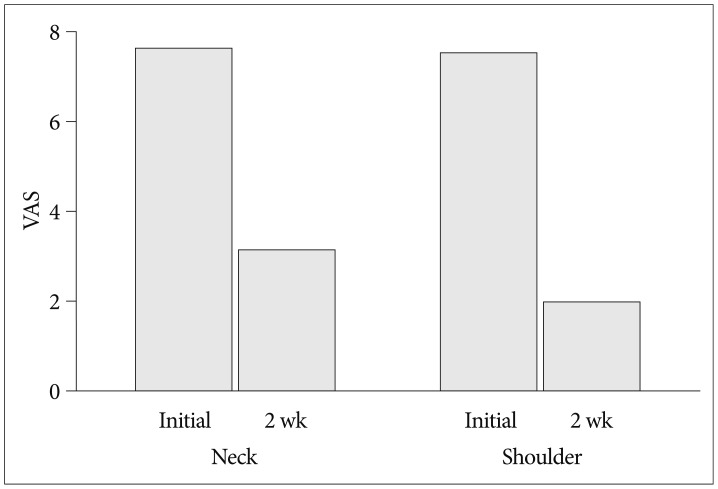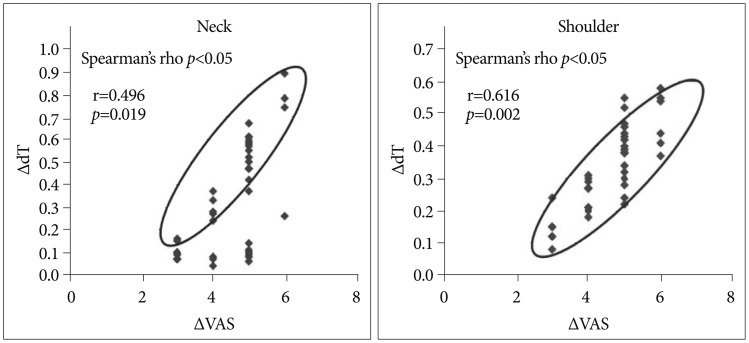J Korean Neurosurg Soc.
2015 Apr;57(4):283-288. 10.3340/jkns.2015.57.4.283.
The Effectiveness of Infrared Thermography in Patients with Whiplash Injury
- Affiliations
-
- 1Department of Neurosurgery, School of Medicine, Inje University Busan Paik Hospital, Busan, Korea. shpaeng@empas.com
- 2Department of Neurosurgery, Wexner Medical Center, Ohio State University, OH, USA.
- KMID: 1956427
- DOI: http://doi.org/10.3340/jkns.2015.57.4.283
Abstract
OBJECTIVE
This study aims to visualize the subjective symptoms before and after the treatment of whiplash injury using infrared (IR) thermography.
METHODS
IR thermography was performed for 42 patients who were diagnosed with whiplash injury. There were 19 male and 23 female patients. The mean age was 43.12 years. Thermal differences (DeltaT) in the neck and shoulder and changes in the thermal differences (DeltadT) before and after treatment were analyzed. Pain after injury was evaluated using visual analogue scale (VAS) before and after treatment (DeltaVAS). The correlations between DeltadT and DeltaVAS results before and after the treatment were examined. We used Digital Infrared Thermal Imaging equipment of Dorex company for IR thermography.
RESULTS
The skin temperature of the neck and shoulder immediately after injury showed 1-2degrees C hyperthermia than normal. After two weeks, the skin temperature was normal range. DeltaT after immediately injuy was higher than normal value, but it was gradually near the normal value after two weeks. DeltadT before and after treatment were statistically significant (p<0.05). VAS of the neck and shoulder significantly reduced after 2 week (p=0.001). Also, there was significant correlation between DeltadT and reduced DeltaVAS (the neck; r=0.412, p<0.007) (the shoulder; r=0.648, p<0.000).
CONCLUSION
The skin temperature of sites with whiplash injury is immediately hyperthermia and gradually decreased after two weeks, finally it got close to normal temperature. These were highly correlated with reduced VAS. IR thermography can be a reliable tool to visualize the symptoms of whiplash injury and the effectiveness of treatment in clinical settings.
MeSH Terms
Figure
Reference
-
1. Ammer K, Schartelmueller T, Melnizky P. Thermal imaging in acute herpes zoster or post-zoster neuralgia. Skin Res Technol. 2001; 7:219–222. PMID: 11737816.
Article2. Anbar M. Quantitative Dynamic Telethermometry in Medical Diagnosis and Management. Florida: CRC press;1994. p. 13–35.3. Anbar M, Gratt BM, Hong D. Thermology and facial telethermography. Part I : history and technical review. Dentomaxillofac Radiol. 1998; 27:61–67. PMID: 9656868.
Article4. Barnsley L, Lord S, Bogduk N. The pathophysiology of whiplash. In : Malanga GA, editor. Spine : State of the Art Reviews. Philadelphia: Hanley & Belfus;1998. p. 209–242.5. Bogduk N. The anatomy and pathophysiology of whiplash. Clin Biomech (Bristol, Avon). 1986; 1:92–101.
Article6. Bogduk N. Treatment of whiplash injuries. In : Malanga GA, editor. Spine : State of the Art Reviews. Philadelphia: Hanley & Belfus;1998. Vol 12:p. 469–483.7. Breasted JH. The Edwin Smith Surgical Papyrus. Published in facsimile and hieroglyphic transliteration with translation and commentary in two volumes. Chicago: The University of Chicago Press;1930.8. Cassidy JD, Carroll LJ, CÔté P, Lemstra M, Berglund A, Nygren A. Effect of eliminating compensation for pain and suffering on the outcome of insurance claims for whiplash injury. N Engl J Med. 2000; 342:1179–1186. PMID: 10770984.
Article9. Chen HB, Yang KH, Wang ZG. Biomechanics of whiplash injury. Chin J Traumatol. 2009; 12:305–314. PMID: 19788851.10. Crowe HD. Whiplash injuries of the cervical spine in proceedings of the section of insurance negligence and compensation law. Chicago: American Bar Association;1928. p. 76–84.11. Fischer AA. Documentation of myofascial trigger points. Arch Phys Med Rehabil. 1988; 69:286–291. PMID: 3281631.12. Grauer JN, Panjabi MM, Cholewicki J, Nibu K, Dvorak J. Whiplash produces an S-shaped curvature of the neck with hyperextension at lower levels. Spine (Phila Pa 1976). 1997; 22:2489–2494. PMID: 9383854.
Article13. Gunzberg R, Spalski M. Whiplash injuries : current concepts in prevention, diagnosis and treatment at the cervical whiplash syndrome. Philadelphia: Lippincott-Raven;1998. p. 283–291.14. Kwon OJ, Yu KS, Lee YG. Trigger points : clinical implications of digital infrared thermographic imaging. J Korean Acad Rehabil Med. 1991; 15:527–533.15. Lawson R. Implications of surface temperatures in the diagnosis of breast cancer. Can Med Assoc J. 1956; 75:309–311. PMID: 13343098.16. Lim KJ. Pain and Thermography. J Korean Pain Soc. 2004; 17(Suppl):S29–S35.
Article17. Lord SM, Barnsley L, Wallis BJ, Bogduk N. Chronic cervical zygapophysial joint pain after whiplash. A placebo-controlled prevalence study. Spine (Phila Pa 1976). 1996; 21:1737–1744. discussion 1744-1745. PMID: 8855458.18. Lord SM, Barnsley L, Wallis BJ, McDonald GJ, Bogduk N. Percutaneous radio-frequency neurotomy for chronic cervical zygapophyseal-joint pain. N Engl J Med. 1996; 335:1721–1726. PMID: 8929263.
Article19. Paeng SH, Jung YT, Pyo SY, Kim MS, Jeong YG. Is the use of digital infrared thermal imaging useful in whiplash injury? Korean J Spine. 2009; 6:274–279.20. Panjabi MM, Cholewicki J, Nibu K, Grauer JN, Babat LB, Dvorak J. Mechanism of whiplash injury. Clin Biomech (Bristol, Avon). 1998; 13:239–249.
Article21. Pettersson K, Toolanen G. High-dose methylprednisolone prevents extensive sick leave after whiplash injury. A prospective, randomized, double-blind study. Spine (Phila Pa 1976). 1998; 23:984–989. PMID: 9589535.
Article22. Pochaczevsky R, Wexler CE, Meyers PH, Epstein JA, Marc JA. Liquid crystal thermography of the spine and extremities. Its value in the diagnosis of spinal root syndromes. J Neurosurg. 1982; 56:386–395. PMID: 7057236.23. Smith J, Everett CR. Prognosis after whiplash-related injury. In : Malanga GA, editor. Spine state of the Art Review. Philadelphia: Hanley & Belfus;1998. p. 287–300.24. Spitzer WO, Skovron ML, Salmi LR, Cassidy JD, Duranceau J, Suissa S, et al. Scientific monograph of the Quebec Task Force on Whiplash-Associated Disorders : redefining "whiplash" and its management. Spine (Phila Pa 1976). 1995; 20(8 Suppl):1S–73S. PMID: 7604354.25. Uematsu S. Symmetry of skin temperature comparing one side of the body to the other. Thermol. 1985; 1:4–7.26. Uematsu S, Edwin DH, Jankel WR, Kozikowski J, Trattner M. Quantification of thermal asymmetry. Part 1 : Normal values and reproducibility. J Neurosurg. 1988; 69:552–555. PMID: 3418388.27. Wexler CE. Thermographic evaluation of trauma (spine). Acta Thermographica. 1980; 5:3–10.28. Zhang HY, Cho BY, Kim HS, Cho YE. Thermo-graphic diagnosis of whiplash injury with/without radiculopathy. Key Eng Mater. 2006; 321-323:845–848.
Article
- Full Text Links
- Actions
-
Cited
- CITED
-
- Close
- Share
- Similar articles
-
- Application of infrared thermography in dentistry
- Comparison of the Clinical Effectiveness Between Infrared Thermography and Electrophysiology Tests in Spinal Intradural Extramedullary Schwannoma
- Digital Infrared Thermographic Imaging(D.I.T.I.) in Herniated Lumbar Disc Patients
- The Clinical Significance of Infrared Thermography in Patients with Chronic Pelvic Pain
- Pain and Thermography




